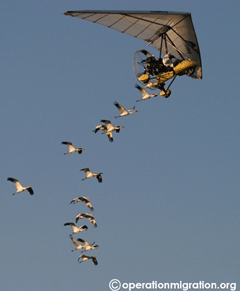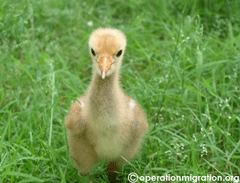Farewell to the Flock of 2006
Air Date: Week of February 16, 2007

Juvenile whooping cranes follow an ultralight to learn the migration route to Florida.((c) Operationmigration.org)
When a tornado hit Florida earlier this month seventeen endangered whooping cranes were killed. Joe Duff is the co-founder of Operation Migration, a non-profit that trains cranes to migrate and re-integrate into the wild. He’d flown 1200 miles with the young birds who were lost in the storm, and tells host Steve Curwood about his work with the birds.
Transcript
CURWOOD: They call it a whooping crane because it has more than an eight-foot trachea, and can be heard for up to three miles away. But this voice almost fell silent.In 1941 whooping cranes were just 15 birds away from extinction. Today the numbers are back up to nearly 500 hundred, but these magnificent wading birds still hover on the edge of survival.
And they recently took another serious blow. Earlier this month a tornado ripped through the Gulf coast of Florida. It killed twenty people and seventeen whooping cranes in the Chassahowitzka National Wildlife Refuge near Tampa. The story of what happened to the birds and how a flock of whooping cranes got to Florida in the first place is rather remarkable, and perhaps best told by Joe Duff the co-founder of Operation Migration.
He joins us on the phone from Port Perry, Ontario, and Joe, perhaps you should start by telling us what you do for a living.
DUFF: (laughs) You wouldn’t believe it if I told you.
CURWOOD: Go ahead.
DUFF: Actually I run an organization that teaches whooping cranes, young whooping cranes, to follow ultra light air craft. And then we use that technique to lead them on a migration from Wisconsin to Florida. And ah, thereby we substitute for the parent and establish a new flock.

Juvenile whooping cranes follow an ultralight to learn the migration route to Florida. ((c) Operationmigration.org
CURWOOD: This is the University of Migration?
DUFF: Yes it is actually, flight school.
CURWOOD: So, how far did you fly with the flock that was killed in this month’s storm?
DUFF: Every year, every fall, we start the migration that goes through seven states from Wisconsin to Florida and it’s about 1235 miles.
CURWOOD: Ok, how do you train a bird to migrate?
DUFF: (laughs) Well the whooping crane, like a lot of species, learns to migrate by following their parent. These are precocial birds so when they hatch they imprint on the first thing that really pays attention to them. And that’s normally of course the parent. So we substitute parent for pilot and we imprint the birds on our handlers. And then of course we condition them to follow the aircraft. It’s a process that starts in April and May when they hatch and is carried on right through the summer to their migration time which is in early October.
CURWOOD: So can you tell me about some of the birds that flew down to the wildlife refuge with you this past fall?
DUFF: Well I’ll give you a little background first. This whole process takes place in what we call isolation rearing. Every person that goes near the birds, and there are very few of them, wears a big baggy white costume head to toe. We also carry a digital recorder of an adult bird call and a puppet that looks like a whooping crane. The idea is not to look like a crane it’s to disguise the human form so that when these birds are released and they encounter their first normally dressed human they’ll be wild. So on their level you actually become a bird.
CURWOOD: How did you fit into the pecking order of this particular flock of birds?
DUFF: (laughs) Well, I’m not by myself. There’s several handlers, each one has a personality and each one has a relationship with the birds. I’ll give you an example um. Last year I wanted to get some photographs. So I put my costume on and I walked out. And as I approached one of our birds from a previous generation one of our older birds came in and of course wanted to get near the chicks and wanted some of the food and wanted some of that activity. And they can be pretty aggressive so I stood between them and I challenged that adult bird, you see. And of course the first challenge is he raises his head and I raise my head and we have this little altitude battle until I win of course because I’m six feet tall.

A baby whooping crane. ((c) Operationmigration.org)
Then finally after about an hour he just left on his own. It was just amazing interaction with a bird. It was such an incredible thing to do.
CURWOOD: Tell me about some of the birds that flew down to Florida with you this past fall.
DUFF: Well, as I said each one has an individual personality. But we don’t name the birds we number them. We number them. We’re trying to convey the idea to the public that these are not pets. But you certainly become attached to them. There’s one particular bird that I like, was number ten. I could recognize that bird in the air because his primaries were a little damaged there was a little gap in one of his feathers and I could see it in the air.
And every time I’d look out to my wing tip that bird’d be lead you know. And he always would be doing something stupid. He’d be in front of the wing or challenging me. He’d cut behind the air craft or over top of it or underneath it. Number ten was always somewhere he wasn’t supposed to be. He was always leading the flock off somewhere. So, you know, I kind of got to like him. He was a bit of a maverick.
CURWOOD: (laughs) And uh and then you get the news that this tornado has killed this entire flock. What happened when the storm hit the wildlife refuge where the young birds were staying?
DUFF: Well, of course we don’t know because it was way out there. But um, um once the birds arrive in Florida we have a release pen which is about four acres and it has eight-foot-high walls and it’s protected by an electric fence. But it’s not top netted. They fly in and out during the day and they learn to forage on natural food. And at night time they come back because that’s where they roost and that’s where the food is. And they’re inadvertently protected from predators.
Well, we now have four, five generations of birds that have all wintered in that pen. So that’s their destination when they come back once they’re released. So if they arrive at that pen and there’s a bunch of chicks handy that means there’s free food for them as well and they become aggressive. They can chase the chicks out of the pen. So the only management technique we have is to move the chicks into a top netted pen. Ah, once we do that the food of course is gone. The target of their aggression is gone and they just move on. And the chicks are allowed to go free and we were just about to do this when this unforecast and unforeseen storm hit. Nobody knew it was going to be as intense as it was. We had, ah, handlers out there checking the birds at four in the afternoon. Everything was fine, the birds were happy and there was just a light breeze and it was overcast. Then that storm turned deadly at three in the morning and, ah, the birds were discovered the next day.
CURWOOD: How big of an impact will the loss of the hatchlings of 2006 have on the overall population of whooping cranes here in North America?
DUFF: Well, as you mentioned earlier back in the forties there were only 15 birds and this population was growing nicely. That was our sixth year and we had 81 birds out there. We had an 80 percent survival rate. So it was ah, we were doing really well. Whooping cranes breed when they’re three to five years old, most successfully at five years of age. So five years from now, or actually four years from now ‘cause they were yearlings we’re going to have a downturn in the number of nests we have and the number of breeding pairs coming on line.
CURWOOD: As I understand there is a bit of a story of hope here. You had a survivor?
DUFF: Yes, we don’t know how but one bird managed to escape that terrible storm. You know that storm was considered, you know, a fifty year storm. There were also 20 people killed in that same episode so it was a pretty devastating event. We really don’t know how but the next day number 15 couldn’t be found. And each bird has a tracking device on it. So the next day we put an aircraft up with a tracking device and it was found about ten miles inland with a bunch of other sandhills. So that’s one bird at least.
CURWOOD: Joe Duff is cofounder of Operation Migration and trainer of cranes. Thank you so much.
DUFF: Thank you.
Links
Living on Earth wants to hear from you!
Living on Earth
62 Calef Highway, Suite 212
Lee, NH 03861
Telephone: 617-287-4121
E-mail: comments@loe.org
Newsletter [Click here]
Donate to Living on Earth!
Living on Earth is an independent media program and relies entirely on contributions from listeners and institutions supporting public service. Please donate now to preserve an independent environmental voice.
NewsletterLiving on Earth offers a weekly delivery of the show's rundown to your mailbox. Sign up for our newsletter today!
 Sailors For The Sea: Be the change you want to sea.
Sailors For The Sea: Be the change you want to sea.
 The Grantham Foundation for the Protection of the Environment: Committed to protecting and improving the health of the global environment.
The Grantham Foundation for the Protection of the Environment: Committed to protecting and improving the health of the global environment.
 Contribute to Living on Earth and receive, as our gift to you, an archival print of one of Mark Seth Lender's extraordinary wildlife photographs. Follow the link to see Mark's current collection of photographs.
Contribute to Living on Earth and receive, as our gift to you, an archival print of one of Mark Seth Lender's extraordinary wildlife photographs. Follow the link to see Mark's current collection of photographs.
 Buy a signed copy of Mark Seth Lender's book Smeagull the Seagull & support Living on Earth
Buy a signed copy of Mark Seth Lender's book Smeagull the Seagull & support Living on Earth

